8+ Sample Interior Design Contracts
-
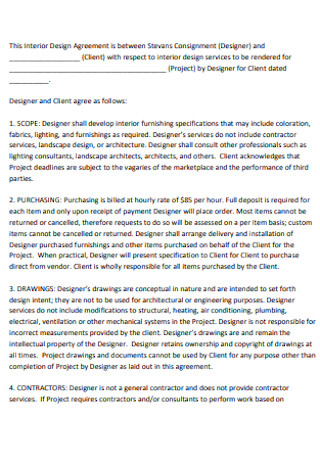
Interior Design Contract Format
download now -
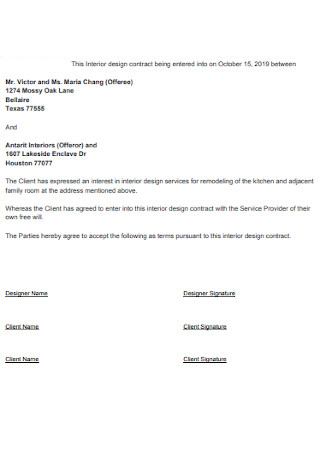
Formal Interior Design Contract
download now -
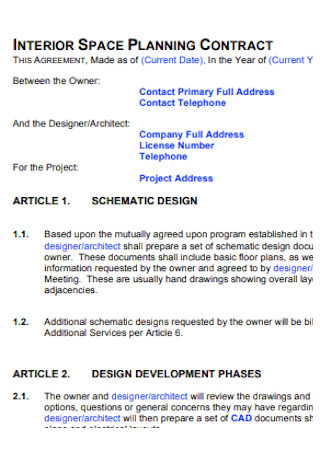
Interior Space Planning Design Contract
download now -
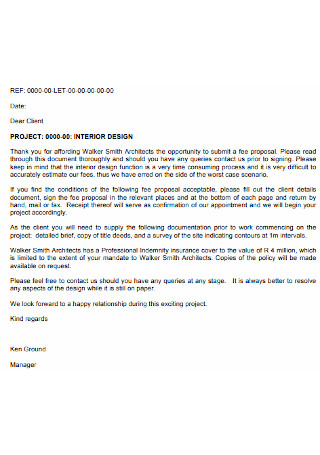
Interior Project Design Contract
download now -
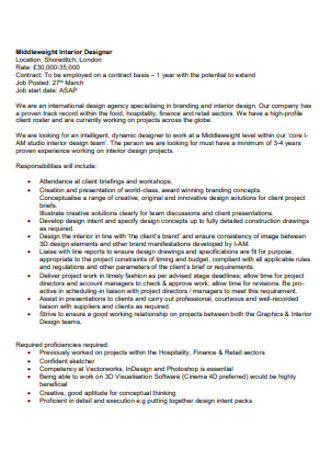
Middleweight Interior Designer Contract
download now -
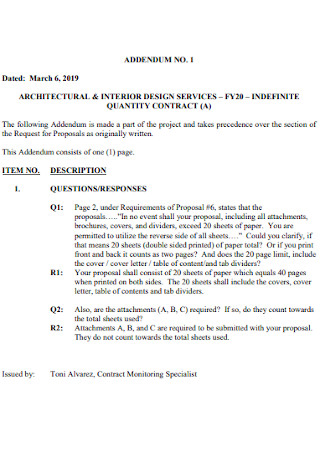
Architectural and Interior Design Contract
download now -
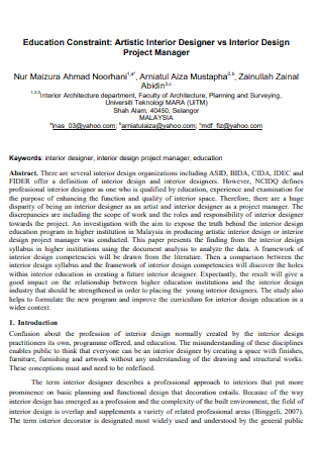
Artistic Interior Designer Contract
download now -
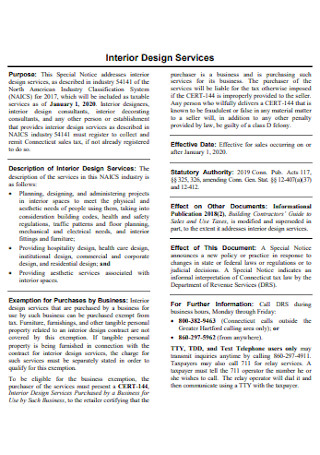
Interior Design Services Contract
download now -
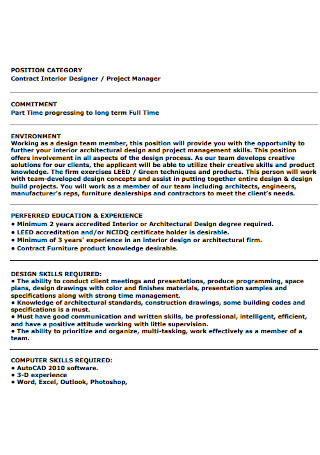
Basic Contract Interior Designer
download now
FREE Interior Design Contract s to Download
8+ Sample Interior Design Contracts
What is an Interior Design Contract?
Parts of an Interior Design Contract
What to Keep in Mind when Making an Interior Design Contract
FAQs
What should an Interior Design Contract Include?
What is an Interior Design Contract
What do Interior Designers do?
If you are an interior designer, you want to feel as secure as what you aim to provide for your clients. One way to do so is securing yourself a written contract agreement that will protect you should unfavorable misunderstandings arise. If you are unsure of how to start, this article will show you the basic clauses that your interior design contract must have and with our Interior Design Contract Templates, you can start drafting one by simply adding in or editing details necessary for the kind of deal you are making with your client.
What is an Interior Design Contract?
Contracts, in general, are legally binding documents that all businesses must have in their arsenal as it outlines the expectations both parties will be looking forward to, define what could be done when these expectations are not met as well as protecting both parties knowing that either of the sides will take accountability should a disruption arise. A contract also functions as evidence that both parties have mutually agreed to commit on the terms and conditions both have indicated and that the only way to go is having to uphold them. Lastly, contracts are there to ensure that services will be paid.
An Interior Design Contract in particular allows an interior designer to define terms and conditions that must be agreed upon by the client to establish expectations and limit conflicts but most importantly protect you from unfavorable situations that are potentially to ensue among deals with clients over interior design services. It generally includes detailed information about the scope of the work, the design fees, and insurance policies among many others.
While most contracts can be independently made by the interior designer, it is ideal to consult a lawyer so they can explain the contract better especially in complex cases and suggest clauses that are in your best interest.
Parts of an Interior Design Contract
Interior Design Contracts can be tailored to the design services you can render or what your client will ask of you although of course, it still has to be mutually agreed upon by both parties. Despite this potential variety, there is a standard format or at least, there are fundamental parts that an Interior Design Contract must have. An employment contract could likewise consist of the following but the following will be more inclined to the nature of an Interior Design Contract. They are as follows:
1. Scope of Work
The Scope of Work is generally what you will be first working on in drafting your contract. It discusses in detail the specific services that will be performed and delivered. The tasks and deliverables must also be exhaustively defined as per the client’s request and what will be done to meet these expectations with explicit mention of how much you will be charging especially if it’s not an hourly but a fixed rate. However, do indicate that the services you will perform do not include services provided by contractors such as architecture, plumbing, lighting, heating, ventilation systems, landscape designs and the like.
2. Design Concept
These will be your drawings that are conceptual in nature based on how your client envisions it and will only be actualized once the project will be implemented and under meticulous planning. Your contract shall also take note that the drawings and plans only serve as visuals and its purposes are solely for the design project alone meaning under no circumstances should they be distributed unless there are special agreements detailing how the design concepts can be used by the client.
3. Design Fees
This clause shall be where the interior designer will inform the client of how the charges will be made and which fee structure will be implemented with no room for questions and assumptions to be made. You may also want to be clear about when you want your client to pay which in most cases is as soon as an invoice is presented. This specific section can be quite difficult as it usually is where clients will turn their backs and reconsider having to work with you but only if you price your service fairly and as much as possible, according to your clients’ situation and the kind of design they want to achieve. However, this does not mean that your opportunity to gain profit should be compromised. After all, you are still running a business and this is your career through which you depend on to make a living and to a certain extent, clients are aware of this and of where fees are dependent on: years of practice, market demand and reputation, to name a few. Curated Home by Chrissy & Co names 3 different ways an interior designer can price their interior design fee which also leaves you an option of combining them as you deem fit for your project’s needs:
4. Purchasing and Procurement
This section in your Contract states how the necessary goods will be acquired on behalf of your client who must have been presented the procurement process and have approved of it. The designer may also indicate in this section if they wish to not place the order themselves until a deposit is presented. The client also has the option to directly purchase the items themselves and if that were the case, it must also be specified in the contract.
5. Refunds and Cancellations
It has to be clearly mentioned that once items are purchased and once orders are placed, they can no longer be returned and be demanded a refund from nor can they be cancelled, especially orders that are custom-made. On the contrary, an interior designer may also indicate under which circumstances can a refund be possible for your client. The contract must also mention cancellation costs and when it must be paid, usually hourly. It all depends on the interior designer’s call. Due to the critical nature of this section, this clause must be especially agreed upon by the client to ensure that no fusses will be made.
6. Reimbursable Expenses
The interior designer contract must include a clause indicating a client’s agreement to reimbursing the designer for out-of-pocket expenses that they have incurred. Reimbursement expenditures sometimes include but are not limited to drafting services, freight and/or postage costs, delivery and storage costs and in some cases, travel, meal and lodging costs that must all be in relation to the project.
7. Payment and Payment Terms
This section of your interior design contract must specify the payment terms and the payment schedule that your client should be informed of so as they are aware of how and when you will be paid. It will also be beneficial especially for you as the interior designer to mention late fee charges and when it will start gathering. Mention as well how work will be halted until invoices will be paid and the next time, on time.
8. Insurance
It is important your contract should mention insurance coverage and how your client is effectively required to be insured of all interior design furnishings and materials during the process of handling, moving, storing and installing them. An interior designer might be more meticulous about insurance coverage especially for large-scale projects.
9. Photography and Publicity
Depending if a client agrees or not, this clause will allow designers to document the project’s progress from the beginning of its implementation until its completion. Documentation, usually in the form of photographs, will be used to expand the designer’s portfolio and as well as publicizing their works online in social media platforms with intentions of marketing and advertising the designer’s capabilities. The designer must keep in mind to be sensible that they do not disclose private information of the client such as their name and their address until consent is granted upon them to do so. However you wish to use the photographs must be clearly defined so clients know what to expect.
10. Termination
Although unlikely and is something both parties would hope to avoid, should a situation arise that require either one of the parties or both to terminate the contract, this section should be able to expound more on the guidelines of the termination process that must be gone through. Of course, a client is given the option to terminate the agreement and once a decision of that nature has been made, the interior designer must be notified through a written document however the client must also be informed beforehand through this clause that outstanding charges will still be made making no actions of harming the designer’s career and their reputation in the industry.
What to Keep in Mind when Making an Interior Design Contract
While there are several things to take into consideration when drafting an Interior Design Contract, we limit them down to the following:
FAQs
What should an Interior Design Contract Include?
An Interior Design Contract includes key parts such as:
- Scope of Work
- Design Concept
- Design Fees
- Purchasing and Procurement
- Refunds and Cancellations
- Reimbursable Expenses
- Payment and Payment Terms
- Insurance
- Photography and Publicity
- Termination
What is an Interior Design Contract
In summary, an Interior Design Contract is a binding agreement between an Interior Designer and a Client that lists terms and conditions both parties have agreed upon. Securing an Interior Design Contract is to ensure that both parties are informed of what must be expected to come out of the project as well as be protected should a misunderstanding arise which ideally, can be prevented if the contract were well-drafted and reviewed by a lawyer.
What do Interior Designers do?
Interior designers typically create spaces within facilities, homes, and condominiums by determining the best ways to liven it up and make it comfortable and aesthetically pleasing.
